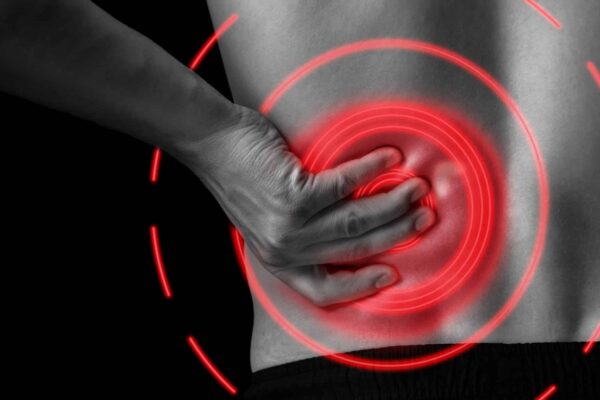If you have lower back pain, regardless of whether it’s a slight twinge when you hit the wrong position or chronic pain from a previous injury, you know how frustrating it can feel. We use our backs constantly, and even a small amount of pain can leave a lasting impact on our lives and daily routines. Our lower backs are complex structures of bones, nerves, joints, muscles, and ligaments. Unfortunately, all of those components can lead to some pretty complex lower back problems with not so simple solutions.
Here’s all you need to know about lower back pain, including how a doctor can properly diagnose and treat your symptoms.
Causes of Lower Back Pain
Lower back pain is usually mechanical due to either the normal wear and tear of the joints and muscles or injury. However, in rare cases, lower back pain can be caused by an underlying issue. Some of the most common causes of lower back pain include:
Strains/Sprains: Most of the time, acute lower back pain can be attributed to a sprain (overstretching of ligaments) or strain (micro tears in muscles or tendons). Car accidents, sporting events, sudden movements, and even small falls can cause sprains and strains.
Disc degeneration: When your lower back is healthy, the discs are allowed to bend and flex. Discs can be considered the spacers or cushions between the vertebral bones. As you age, this “cushion” can stiffen or wear away, making the back less flexible, which means even small movements can be painful.
Sciatica: Sciatica is one of the more painful and common forms of lower back and leg pain. Sciatica is caused by compression of the sciatic nerve roots, the nerves that run from the buttocks to the legs. This compression causes a sharp, burning pain, sometimes extending down the legs and to the feet. While sciatica can often improve with time and medication, sometimes other treatments are needed to relieve the compression. Speak with your doctor right away about your options.
An injury: Car accidents, sports injuries, falls and other accidents can injure tendons, ligaments or muscles resulting in low back pain. Compressive forces from an injury can also lead to ruptured or herniated discs.
Skeletal abnormalities: Scoliosis (a curvature of the spine), lordosis (a larger than typical lower back arch), and other abnormalities in the spine can lead to back pain.
Some of the less common and far more serious causes of lower back pain include infections, tumors, aneurysms, kidney stones, osteoporosis, and fibromyalgia. To treat these causes of back pain, we need to address the underlying cause of pain.
Lower Back Pain Symptoms
Symptoms of lower back pain vary greatly depending on the type and specific location of pain. Pain may begin suddenly or build over time. Some of the symptoms include:
- Dull, achy pain
- Sharp, knife-like pain
- Stinging, burning pain that moves from the low back to the backs of the thighs (usually caused by sciatica)
- Muscle spasms
- Tightness in the lower back and legs
- Pain after sitting or laying down for long periods of time (like when first waking up in the morning)
- Pain when walking or standing
Symptoms come in three main forms: acute, subacute, and chronic pain.
- Acute pain. Acute pain comes on suddenly, usually from a sprain or other injury and lasts for a short period of time.
- Subacute pain. Subacute pain is usually caused by the same factors as acute pain (mechanical problems like sprains and strains), but it lasts longer – up to about 3 months. You should see your doctor if your pain lasts more than a few days or week or if the pain is severe.
- Chronic back pain. Chronic pain is pain that lasts more than 3 months, can be mild to severe
Diagnosing Lower Back Pain
Each doctor will have their own system for diagnosing your lower back pain, but diagnosis will typically involve some combination of the following:
- X-ray: X-rays can check for breaks or fractures as well as show us how much wear and tear changes there are in the spine.
- Magnetic Resonance Imaging (MRI): An MRI uses a magnetic force to create computer-generated images of the lower back. Unlike X-rays, MRI scans also show muscles, ligaments, tendons, and blood vessels, so they can offer a more complete image of the lower back.
- Ultrasounds: Ultrasounds use sound waves to produce images of the lower back. Ultrasound imaging can look for more internal causes of back pain as well show small tears in ligaments, muscles, and tendons.
- Blood tests: Blood tests may be done for acute or chronic pain where there is concern for a more internal cause. A blood test can tell your doctor if you have an infection or disease that’s causing the pain.
- Patient History: Any diagnosis will consider the patient’s medical history, including any past injuries, characteristics of the pain, and lifestyle habits such as posture, weight, and exercise routine.
- Current Symptoms: At the onset of a diagnosis appointment, your doctor will get a full workup of your pain status, including pain severity, location, type, and consistency.
- Physical: A physical should include a careful exam including reflex testing, a leg raise test, strength, flexibility, and range of motion testing.
Early Treatments for Lower Back Pain
Initial treatment may start with self-care and basic pain management with OTC (over the counter) medication.
Self-Care: Some options for self-care include massage therapy, rest days, stretching, and ice or heat application. You don’t need a doctor’s permission to treat your lower back pain. Just make sure that if your pain lasts more than a few days or worsens over time, that you inform your doctor to make sure it’s not serious.
Over-the-counter pain medications: The most common over-the-counter (OTC) medications are aspirin, ibuprofen, naproxen, and acetaminophen. Aspirin, ibuprofen, and naproxen are anti-inflammatory medicines, which help alleviate pain caused by inflammation or swelling. If you have other medical conditions or are on other medications, please check with your doctor before taking these as there are some situations where we advise avoiding anti-inflammatories. Acetaminophen interferes with pain signals sent to the brain. Acetaminophen can often be alternated with anti-inflammatories. It’s best, however, to check with your doctor regarding which medications are best for you.
Non-Surgical Treatments for Lower Back Pain
If self-care isn’t helping, it’s time to see a doctor. Most lower back pain will improve with a combination of time and conservative (non-surgical) measures. Some common non-surgical options include:
Muscle relaxers and pain medications: Muscle relaxers depress the central nervous system, relieving pain from muscle tightness or spasms. Narcotics (also called opioids) interfere with the pain signal to the brain, dulling the perception of pain. Narcotics should only be used for short-term pain management, as they can become addictive.
Epidural steroid injections: The steroid is administered directly into the outer part of the dural sac, which surrounds the spinal cord, immediately (and temporarily) numbing pain.
Physical Therapy: PT is one of the main treatments for lower back pain. Your therapist can help you improve your flexibility, strength, and posture. This is often the most effective way to improve and prevent a recurrence of low back pain.
Alternative Therapy Options: Alternative therapies like acupuncture, massage, and chiropractic care can also help to alleviate the pain.
Chiropractic care: A chiropractor can make physical adjustments to the spine to help alleviate pressure between the joints.
Massage therapy: Massage therapy can temporarily decrease muscle spasms that contribute to back pain. Talk to your doctor, since massage is sometimes covered by insurance.
Surgery for Lower Back Pain
If medications, time, and non-surgical options aren’t enough, you may need to have surgery to reduce your lower back pain. Fortunately, the vast majority of low back pain will improve without surgery. The most common form of back surgery is decompression surgery, a surgery that removes whatever is pressing on the nerve. This could be a portion of a bulging disc, a tumor, or a bone spur.
Most of the time, you’ll have one of the following:
Microdiscectomy: This is a minimally invasive surgery for people with sciatica.
Laminectomy: This surgery removes a portion or layer of bone that’s pushing into a disc.
For more information on how to manage your lower back pain, contact Peninsula Doctor. Our combination of preventative and diagnostic care can help keep your back healthy and as pain-free as possible.


